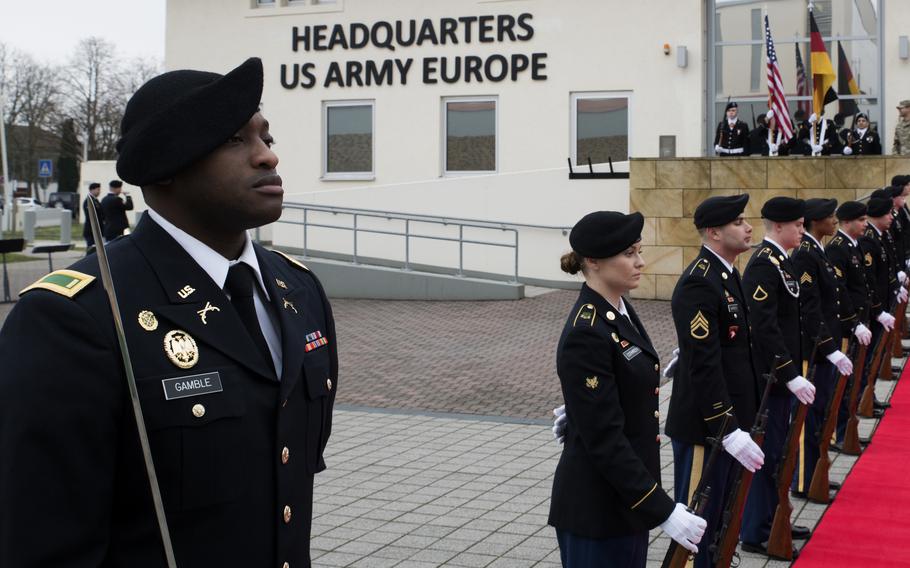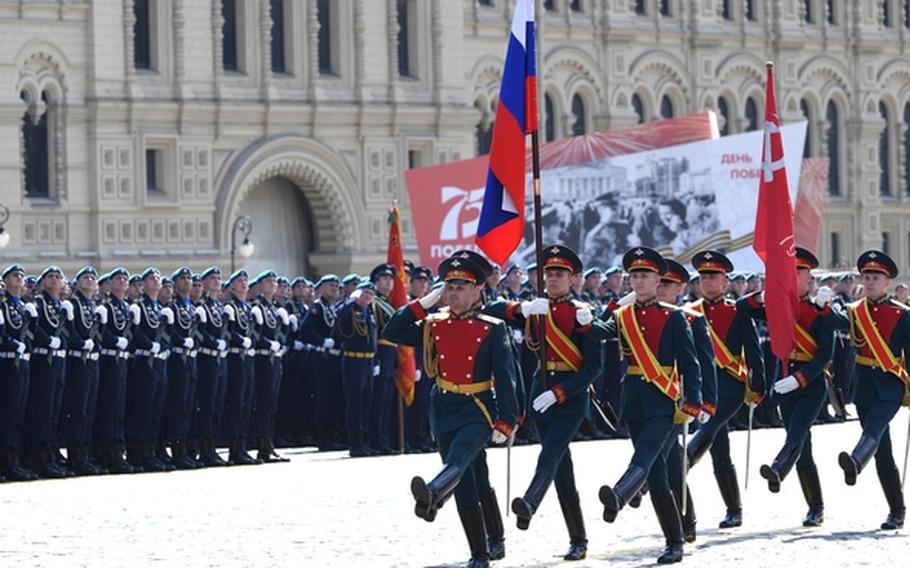
Soldiers stand outside U.S. Army Europe headquarters in Wiesbaden, Germany, on Jan. 13, 2020. Later that year, the command assembled a group of former officers to study Russia's military actions. The command published a report on July 21, 2025, detailing how Russia has fought its war in Ukraine. (Stephen Perez/U.S. Army)
STUTTGART, Germany — The U.S. Army in Europe on Monday published a 357-page chronicle of Russian fighting in Ukraine intended to help commanders understand how the Kremlin wages war.
Covering the conflict from February 2022 to July 2024, the report, titled “How Russia Fights,” is the result of a yearslong effort by a team of former American officers brought out of retirement.
The report delves into all aspects of the conflict, ranging from Russia’s command and control practices to ground force maneuvers and the emergence of small drones on the battlefield.
It also issues a broader warning that the Russian invasions of Ukraine in 2014 and 2022 weren’t isolated events.
“Conceptually, this war is far bigger than Ukraine — at least for Russia,” the authors wrote. “Russia sees itself in a global conflict with the West, of which Ukraine is but one theater. Neither success nor failure in Ukraine will alter Russia’s global calculus.”
The report was compiled by a group of retired, Russian-speaking Army foreign area officers assembled in 2020 by then-U.S. Army Europe and Africa commander Gen. Christopher Cavoli to rebuild Cold War-era Russia expertise.
Calling themselves “the Troika,” the team initially designed a training program for Army leaders to fill a Russia knowledge gap.
With the full-scale invasion in 2022, their work gained new urgency.
“The Troika watched with rapt attention,” the advisers wrote in the opening to their collection of Russia insights. “We were anxious to see how well our curriculum held up in a real Russian large-scale combat operation.”
Many assumptions turned out to be correct, but there were some surprises, they said.
The advisers scoured open-source, unclassified Russian and Ukrainian reporting and social media to make regular reports to Cavoli and his command team.

Russian honor guardsmen participate in a military ceremony in Moscow on June 24, 2020. U.S. Army Europe and Africa released a report titled "How Russia Fights" on July 21, 2025, examining Russia’s war in Ukraine between February 2022 and June 2024. (Russian Defense Ministry)
Known as “Troika Observations,” the often-daily insights were sent out to more than 3,300 military officials, “including some of the most senior military and civilian leaders” in the Defense Department.
“We filtered these raw observations through more than 200 years of collective (Russia) experience and accumulated wisdom working the Russia problem set,” the group wrote.
The new report distills those observations from the first two-plus years of the war. More reports are expected. Several former officers co-authored the work, including retired Col. Ted Donnelly, who served as the report’s managing editor.
The Troika emphasized that the war’s beginnings go back to Russia’s 2014 invasion and subsequent annexation of the Crimean Peninsula.
A lack of attention to the 2014-2022 period, they said, is one reason some pundits wrongly predicted Ukraine would collapse quickly in 2022.
“Those who were surprised by Russia’s poor performance in the winter and spring of 2022 were ignoring the fact that after Russia’s illegal annexation of Crimea in March 2014, Russian indirect actions in the Donbas (region in eastern Ukraine) largely failed,” the Troika wrote.
“They ignored the fact that Ukraine largely blunted repeated Russian conventional offensives from 2014 to 2022. They were oblivious to Ukraine building Europe’s most powerful ground force (not an exaggeration), numbering 28 maneuver brigades.”
But while Russia suffered major setbacks early, conditions have shifted.
In a 2023 observation, the Troika wrote that “after 9 years, this is a war of attrition, and Russia is winning.”
Such a war “suits Russia well—Russia has nearly 3.5 times the population of Ukraine and has not had trouble raising additional forces,” the document stated. “The mobilization process has been ugly to American eyes, but it worked.”
The report highlights Russia’s willingness to absorb huge casualty numbers for small battlefield gains.
“Although to American eyes repeated human-wave frontal attacks look senseless, even criminal, they have been effective,” the Troika wrote.
For example, Russia had about 10,000 of its troops killed, wounded or missing in action in its campaign to seize the small town of Soledar, which had a pre-2022 population of just 10,000, the authors wrote.
Among the surprises during the war has been the scale of death Russian leaders were willing to tolerate.
In 2023, Ukraine’s then-top commander, Gen. Valerii Zaluzhnyi, said he had underestimated that willingness, adding that “in any other country such casualties would have stopped the war.”
Circumstances have continued to change since the report’s cutoff in mid-2024.
U.S. President Donald Trump has repeatedly pushed for a peace deal, but those efforts have stalled.
In recent weeks, Trump has taken a tougher stance on Russia and said the United States will send weapons back into Ukraine via NATO, which will foot the bill.
Whether negotiations are possible in the near term remains unclear. In the meantime, the report warns, Russia will continue to adapt.
“Often, Russian learning proceeds at a slower pace than one might expect,” the authors wrote. “Many adaptations seem counterintuitive or incomprehensible to U.S. observers, because they are Russian solutions, and the Russians are different.
“Nonetheless, they are adaptations,” the report continues. “We should not underestimate (Russia’s) ability to overcome.”